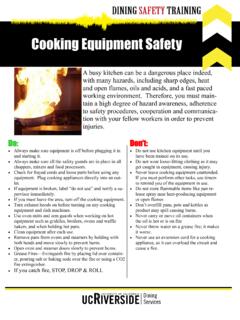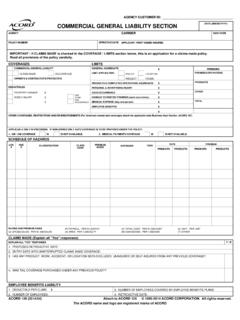Transcription of YOUR SPEAKING VOICE
1 YOURSPEAKINGVOICETips for Adding Strength and Authority to Your VoiceWHERE LEADERS ARE MADEYOURSPEAKINGVOICETOASTMASTERS Box 9052 Mission Viejo, CA 92690 USAP hone: 949-858-8255 Fax: 2011 Toastmasters International. All rights reserved. Toastmasters International, the Toastmasters International logo, and all other Toastmasters International trademarks and copyrights are the sole property of Toastmasters International and may be used only with 62011 Item 199 WHERE LEADERS ARE MADE2 YOUR SPEAKING VOICECONTENTSThe Medium of Your Message .. 3 How Your VOICE Is Created .. 4 Breath Produces VOICE .. 4 Production of VOICE Quality .. 4 What Kind of VOICE Do You Have? .. 5Do You Whisper or Boom? .. 5 Are You Monotonous or Melodious? .. 5Is Your VOICE a Rain Cloud or a Rainbow?
2 5Do You Have Mumblitis? .. 5 How Well Do You Articulate? .. 5Do You Trudge Like a Turtle or Race Like a Rabbit? .. 6Do You Agitate or Orchestrate? .. 6 Your Speech Profile .. 7 How to Improve Your SPEAKING VOICE .. 7 Methods for VOICE Relaxation .. 7 Breathing Exercises to Improve Volume .. 8 Extending and Controlling Your Pitch .. 9 Projecting Your VOICE .. 9 Improving Your Articulation ..10 Talk With Time, Not Against It .. 12 Spice Up Your SPEAKING ..14 Rehearsing Speeches .. 17 Presenting Speeches .. 17 Your VOICE and Your Image .. 17 Speech Profile .. 19 YOUR SPEAKING VOICE 3 Your audience judges you from the moment you stand up to speak. If you are dressed well and are neat and clean, their initial impression of you will be positive. However, if your VOICE is squeaky, your words unintelligible, or your VOICE too loud, their positive impression quickly will become negative.
3 If you want to communicate effectively and positively influence your audience, you must pay special attention to your SPEAKING MEDIUM OF YOUR MESSAGEYour greatest tool as a speaker is your VOICE . Every time you address an audience your mind, your body, and your VOICE act as partners in your effort to communicate with your listeners. When you speak, your VOICE is the primary link between you and your listeners. It is the medium of your most likely the VOICE you are now using is not your best VOICE . You may have buried your optimum SPEAKING VOICE under layers of bad speech habits. However, you must find it and put it to work if you want to become a good speaker. This manual will help you add dimension, strength, vitality, and authority to your SPEAKING effective VOICE isn t necessary just for public SPEAKING .
4 A good, controlled VOICE is an asset in every contact with others. Your VOICE mirrors your personality with a language all its own. A natural VOICE which projects cordiality, cultivation, and authority is a significant tool for personal success. It can help in gaining promotions, making sales, winning the respect of others, and improving your social opportunities, as well as in SPEAKING effectively to you speak, your VOICE reflects your psychological and emotional state of mind. You cannot hope to persuade or influence others or even get them to listen in a positive way if your tones are harsh and unfriendly. Such a VOICE can repel even when the speaker wishes to attract. The quality of friendliness is a requirement for a good SPEAKING VOICE . It is largely a matter of habit, as is the unfriendly you scold, snarl, and speak in an unpleasant tone and you want to produce the genial, cheerful, and gracious tones that characterize a good SPEAKING VOICE , you may need to do more than simply develop your VOICE .
5 You may have to reassess how you look at yourself, other people, and events in most likely you can develop the sort of VOICE that wins favorable attention and reflects the qualities you wish to project. You simply have to strip away any bad speech habits and replace them with positive ones that will enhance your SPEAKING of your goals as a speaker should be to develop a VOICE that is: pleasant, conveying a sense of warmth natural, reflecting your true personality and sincerity dynamic, giving the impression of force and strength even when it isn t especially loud expressive, portraying various shades of meaning and never sounding monotonous or without emotion easily heard, thanks to proper volume and clear articulation4 YOUR SPEAKING VOICEHOW YOUR VOICE IS CREATEDB efore you try to improve your SPEAKING VOICE , you should first learn how speech sounds are produced.
6 This is the process that you can change in order to improve your speech. As you read about the process, refer to the following Produces VoiceDeep, controlled breathing is necessary for good vocal production. Your VOICE is supported by a column of air, the depth and steadiness of which determines your vocal quality. Think of the dia-phragm as the foundation on which this air column rests and by which it is controlled as it comes upward to meet the vocal you breathe in, your abdominal wall expands and the dome-shaped diaphragm flattens. When you exhale, the diaphragm relaxes and the abdominal wall contracts. The relaxed diaphragm rises, pushing air out of the lungs. The exhaled air provides the controlled production of speech the air pushes upward against the vocal cords, it causes them to momentarily separate, allowing the air to pass between them.
7 The rush of air and the elasticity of the vocal cords then pulls them back together. The production of these vibrations is called how sound is produced at the mouth of an inflated balloon. Vocal sound is produced in a similar manner. Air pressure comes up through the throat, mouth, and nose, causing a continuous pressure change in the air surrounding the speaker. These pressure changes are called sound waves. They are transmitted to the ear of the listener and the VOICE is of VOICE QualityThink for a moment about musical woodwind and brass instruments. Their sound comes from the musi-cian s breath and lip vibrations or the vibrations of a reed in the mouthpiece. Because the chambers of these instruments differ in size and shape, their tone qualities are distinctive.
8 Different parts of the original tone are increased, or resonated, and other parts are resonation is the increasing or modifying of sounds by the throat, nose, and mouth. The sound waves created by the vibration of the vocal cords travel into the upper part of the throat, then to the mouth and, at times, into the nose. As these waves bounce around within these structures, they are reinforced and differences in people s voices arise from the size of the vocal cords and the effects that the resonators (throat, mouth, nasal passages) have on the vocal a certain extent, a speaker can change the size, shape, and surface tensions of the pharynx and the oral cavity; he or she may also use, partly use, or close off the nasal SPEAKING VOICE 5 WHAT KIND OF VOICE DO YOU HAVE?
9 Do You Whisper or Boom?Some people speak too loudly. At the other extreme are those who can barely be heard. VOICE loudness or volume should be appropriate in strength and intensity and should be varied in order to add emphasis and dramatic impact to your speeches. Inaudibility is different from SPEAKING softly with vocal support. A whisper is air without sound; air must vibrate against your vocal cords to produce audible sound. A fading VOICE is first cousin to a whisper; a sentence or phrase may begin well enough, then collapse into unintelligibility. If you want to communicate with your audience, you must project your You Monotonous or Melodious?When you speak about something, does your VOICE convey life, color, and melody, or do your sentences come out flat, wooden, and without variety?
10 Do people find your vocal range pleasant? Good speakers vary their speech to express emotion and conviction. The highness or lowness in the sound of your VOICE is known as pitch. If your VOICE is squeaky, guttural, shrill, or flat, then you should work on your pitch. The desired SPEAKING pitch sounds low, clear, full, and Your VOICE a Rain Cloud or a Rainbow?The essence of your SPEAKING sound is your VOICE quality. It expresses emotional color. Your VOICE coloring is what you use to convey your feelings, and these feelings should be positive when you address an audience. Your thoughts are a form of energy that you transmit to others. Through the quality of your VOICE , you actually establish the tone of your relationship with an audience or with an individual to whom you re speak-ing.

















